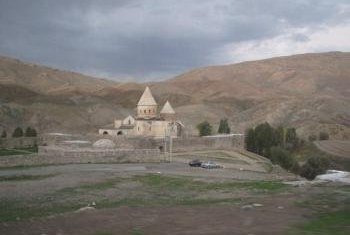
It is a serial nomination, but consists only of two elements, the St Stephanos monastery near Jolfa, and the "Black Church" (or, officially St Thaddeus monastery) near Maku. It is possible to do both on one day, but it will be a long and exhausting journey. Though theoretically one can get an Iranian tourist visa without having a local agency to fix his travel arrangements, it is advisable to have one, specially if you want to visit off the beaten track destinations - like these monasteries - as public transport will not take you there. Prior arrangements are helpful financially also, as - due to the sanctions still in function - no credit cards work in Iran, and bank transfers are also quite difficult. We made the arrangements through an Iranian friend, who hired a vintage Mercedes bus for us - the best option available in Tabriz. As our maximum speed on highways was cca 40 km/h, long journeys looked even longer.
St Stephanos is much easier to reach - but far less interesting than the Black Church. It is close to Jolfa, a bustling border town, that connects the Islamic Republic both with Armenia and with Azerbaijan. Jolfa is an easy two-three hours trip from Tabriz, the capital of the province, and the place most probably you will spend the night. From Jolfa the road winds near river Arax, the border with Armenia. The natural setting of the monatery is really stunning - on a lush green slope, looking down on the river valley. The car park is cca 2-300 m from the monastery. While climbing up to the gate we noticed that even though it meant to be a Christian pilgrimage place, the grounds surrounding the monastery were packed with seemingly Muslim families having picnick lunches in the green - the favorite pastime of Iranians deprived from most of the amenities of the West.
Though the monastic ensemble was founded in the 9th century, what we can see now is a much later structure. It was heavily reconstructed in the Safavid times and again in the 19th century. The monastery as a whole is quite nice and interesting - full with tourists from the other side of the border, but the main church is rather diasppointing with its fully reconstructed interior and less than mediocre icons.
From Jolfa the Black Church is another four hours trip. The landscape is very different. St Thaddeus Monastery stands in a deep valley surrounded by barren grey hills. (picture)
The monastery is visible from a distance because of the massiveness of the church, strongly characterized by the polygonal drums and conical roofs of its two domes. There are several chapels nearby: three on the hills east of the stream, one approximately 3km south of the monastery on the road to Bastam, and another that serves as the church for the village of Ghara-Kilise.Legend has it that a church dedicated to him was first built on the present site in AD 68.
Not much appears to remain of the original church, which was extensively rebuilt in 1329 after an earthquake damaged the structure in 1319. Nevertheless, some of the parts surrounding the altar date from the 10th century.
Much of the present structure dates from the 19th century when a Qajar prince gave money to raconstuct the then ruinous structure.
The Turkish border (Bozorgan) is quite close - less than one hour - from there. Bozorgan is a big busy border station, open 24 hours, so the best option, if you want to see both monasteries in one day, either to spend the night in Turkey, cross the border early in the morning see the Black Church and then further your way to Jolfa and then Tabriz, or the opposite way as we did it.
Both monasteries ask for an entrance fee -100 and 150 000 rial respectively.
Comments
No comments yet.
